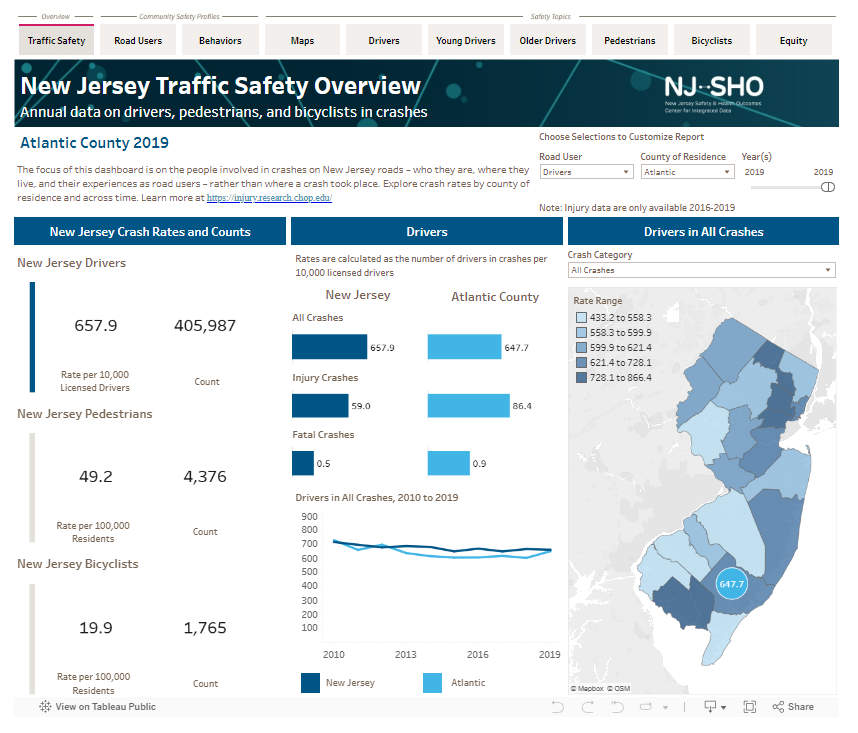About the Center
The New Jersey Safety and Health Outcomes (NJ-SHO) Center for Integrated Data at Children's Hospital of Philadelphia's Center for Injury Research and Prevention is reimagining how safety and health data are collected, integrated, analyzed, and shared to support safe transport in NJ. Together with the New Jersey Division of Highway Traffic Safety (HTS), we are sharing innovative people-focused data with communities across the state.
NJ-SHO Center for Integrated Data
History
Researchers at the Center for Injury Research and Prevention (CIRP) at Children’s Hospital of Philadelphia (CHOP) created the NJ-SHO Center for Integrated Data to provide valuable information about injuries and traffic safety to stakeholders across NJ. The origin of the NJ-SHO Center for Integrated Data began in 2010 when Dr. Allison Curry worked with Melissa Pfeiffer to link NJ crash and licensing records to evaluate the impact of a Graduated Driver Licensing (GDL) program on young drivers. This research was the beginning of the NJ-SHO Data Warehouse and was supported by the Robert Wood Johnson Foundation.
Over the next few years, we added additional sources to the data warehouse through grants funded by the Eunice Kennedy Shriver National Institute of Health and Child Development. These grants focused on populations of drivers with ADHD and autistic drivers identified through CHOP electronic health records. We also obtained hospital discharge data, birth certificates, and death certificates with a Data Use Agreement from the New Jersey Department of Health, allowing us to expand our populations of interest and to branch out beyond transportation outcomes to all injury outcomes.
In 2022, we were awarded a grant from the New Jersey Division of Highway Traffic Safety (HTS) to develop an interactive, public-facing website and people-focused data dashboard powered by the NJ-SHO Data Warehouse. Our two main goals are: 1) to encourage data use and data sharing among stakeholders to support safe transport for all and 2) to share information with communities interested in learning how to use data integration and visualization to improve safety.
Mission
Our mission is to promote a safe and healthy NJ through innovative data linkage and data sharing to support community-based solutions that reduce injury and death.
NJ-SHO Data Warehouse
The NJ-SHO Data Warehouse is a linked database of administrative datasets from NJ on traffic safety and health outcomes that currently contains more than 124 million records on 24 million individuals over a 17-year period (2004-2020). By linking records for the same individuals across datasets, their experiences can be seen within the larger context of their lives.


NJ-SHO Data Dashboard
The NJ-SHO Center for Integrated Data and New Jersey HTS are taking a people-focused, data-driven approach to help communities reduce injuries and fatalities on our roadways. Users of the NJ-SHO Data Dashboard can compare transportation safety and injury metrics over time, by community, and by population characteristics. This innovative tool offers 10 views: Traffic Safety Overview, Road Users, Behaviors, Maps, Drivers, Young Drivers, Older Drivers, Pedestrians, Bicyclists, and Equity.
Extensive Research Program
The NJ-SHO Center for Integrated Data team and its partners have published more than 45 peer-reviewed research articles on health and transportation safety and mobility, including the effects of Graduated Driver Licensing laws in NJ, transportation equity, and crash risk of autistic drivers, older drivers, pedestrians, and other vulnerable populations. We have also advanced best practices and developed innovative approaches to manage and analyze traffic safety data.

What's next?
We are excited about conducting the next round of data integration, which will bring in additional years of data for current sources and add Emergency Medical Services data.
